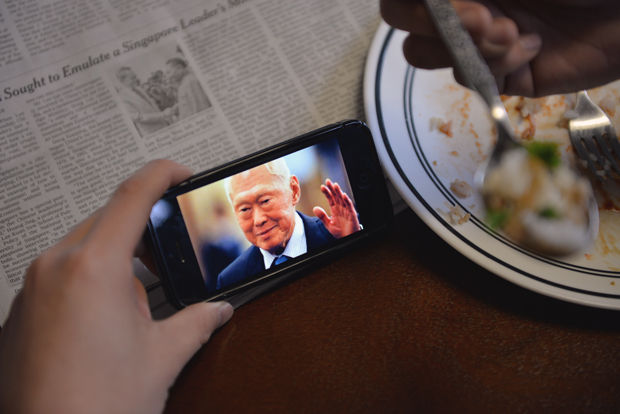A food-eulogy for Lee Kuan Yew
March 25, 2015
The founder of the country I call home died Monday. Lee Kuan Yew, a man known to some as a dictator, others as a quasi-tyrannical ruler, but to many, as the forefather of Singapore.
It’s been a strange emotional ride for most Singaporeans, who are not overtly patriotic. No one cries, really, for our sports teams, nor our actions abroad, which are often quite subtle – your laptop batteries, or a pit stop being a major bunkering port city in which cargo ships refuel.
In 1965 when the announcement was made that Singapore would separate from Malaysia as an independent state, a press conference was held when Mr. Lee broke down and cried for his despair about the separation.
What he said after, however, was more powerful: “We are a going to have a multi-racial nation in Singapore, we will set an example – we are not a Malay nation, this is not a Chinese nation, this is not an Indian nation … Everybody will have a place in Singapore.”
Cheesy and cliché as it may be, it’s translated directly into our food.
As such, I can only imagine the diversity of what Mr. Lee’s eating habits might have been. I like to think it was diverse and varied, perhaps rough, and just as he was a politician, unapologetically forward, uncompromising in quality and complex.
With the soul searching many are having as Singapore turns 50 this year, I’ll write of what I think is a perfect day when eating in Singapore, and what Mr. Lee might have had if he were as ravenous as so many of my fellow Singaporeans are.
For breakfast, coconut jam flavored with pandan (a green, highly aromatic leaf similar to vanilla in smell) otherwise known as kaya, spread on toast that has been grilled over charcoal with a couple of pats of cold butter. Two soft boiled eggs accompany this, cracked open, with a generous dash of hot white pepper and soy sauce over the still runny yolks and the just barely set whites.
It’s a breakfast mashed up from where Singapore’s Chinese and British colonial heritage clashed.
Alternatively, he could have had nasi lemak, a fundamental Malay staple of rice cooked with coconut milk (nasi means rice, and lemak is colloquial for ‘tasty’ that also generally refers to anything cooked with coconut milk) and eaten with sambal, a hot chili jam paste made savory with onions and blachan (fermented fish paste).
A fried chicken wing, an egg, and a couple of slices of cucumber adorn as glorified vessels for the addictive sambal.
As his days moves on giving speeches and cabinet meetings and whatnot, morning tea would be crucial sustenance during the period when eating lunch is not quite socially acceptable.
Perhaps a flaky buttery curry puff, similar to an empanada but spicy and fortified with potatoes, chicken, peas and eggs. Or if not, chwee kueh, small little steamed rice cakes topped with a salty-sweet preserved radish and chili oil – oh so soft, quivering upon the touch.
Of course one of the hardest decisions in the day is what one must have for lunch. Noodles or rice, really, is the deciding factor.
A bowl of bak chor mee (minced meat noodles) would be an excellent decision. Fresh and springy noodles are coated in vinegar, lard and a propriety chili sauce mixture, then topped with minced pork, braised mushrooms, pork liver, dried sole fish, and the all-important bits of crunchy lard. This is quite possibly the thing I miss most from home.
If rice was the way to go, nasi padang it is. Essentially, it’s an assortment of Indonesian-Malay curries. The dish includes braises, stews and stir fries eaten on top of steamed, fluffy, aromatic jasmine rice. At the least one must have beef rendang, a slowly braised piece of chuck in coconut milk spiced with turmeric, galangal, lemongrass, chilies, garlic and shallots.
As afternoon events roll on, Mr. Lee must by now be thinking of dinner.
Seafood feels appropriate. Chili crab, to be specific. One of those giant Sri Lankan crabs, enough for five or six, stir fried in a thick sweet-savory sauce composed of chilies and tomatoes made rich with eggs.
To mop up the gravy has to be man tou, fried fluffy bread pillows – crispy on the outside, hot and steaming on the interior.
Singaporeans don’t stop at dinner though, for one must have supper before going to bed, particularly after a night out.
Roti prata, an Indian flatbread that is flipped out impossibly thin and then folded back to create a layered fried bread most magical, eaten with a little sugar and some curry. Because people cannot live on prata alone, a plate of maggi goreng, stir fried instant noodles with bits of chicken, chilies and curry powder, calms the nerves after a long and eventful day.
Alas, there is so much more to have, so I hope Mr. Lee is in a better place – where stomach capacity doesn’t hinder and where the streets brim with the smells of wonderful, delicious, and Singaporean things to eat.



















